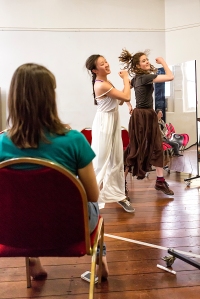
There’s always room at The Blue Room for dance theatre; dancers who are hungry for more than just being seen in the dance community have a way to crossover to a wider audience by getting their work into a Blue Room season. But this crossover benefits more than just the dancers; when theatre and dance come together, the two can create a hybrid product such as we’ve seen in Ian Sinclair’s The Little Mermaid, Perth Theatre Company’s Wish or Barking Gecko’s 1507. And for audiences, exposure to dance theatre through a Blue Room show might also pull theatregoers into the dance community, which can only be a good thing for a healthy, diverse arts sector.
Soon to open at The Blue Room is one such dance theatre piece called Status Room, directed by Jo Pollitt and devised by Daisy Sanders and Shuling Wong. Pollitt is a noted Perth-based ‘slashie’; she’s a dancer/choreographer/writer/lecturer who taught and mentored Sanders and Shuling at WAAPA. Sanders and Shuling formed a working bond while students together, and have been collaborating for months on the piece through not just getting together in the rehearsal room, but through intense social media experiments and near 24/7 exchange of ideas.
Sanders was part of a two week intensive reworking of Pollitt’s piece Beast at WAAPA, and became fascinated with the different kinds of physicality and awareness that the work presented. She began exploring, and through discussions with Pollitt, realised that her discoveries needed a performance-based outcome. Sanders spoke with independent theatre artist Joe Lui, who encouraged her to approach The Blue Room, as they are always on the lookout for dance works. She contacted Blue Room producer Susannah Day to discuss the concept (as you do, if you want to submit an application for inclusion in one of their seasons), and began to put her ideas to paper for the application. She remarks that the application process helped to solidify and crystallise her concept and says, “if I hadn’t had to do that application, it wouldn’t have grown so much thematically.”
She soon realised, after speaking with Day about The Blue Room’s requirements that she would need a producer on board to handle all the administrative work that goes along with producing a season. She and Pollitt both agree that they quite enjoy the administrative aspect of putting on work, and that it can be hard for creative artists to give up control of certain aspects of their projects. Pollitt says of ‘artists-slash-control freaks’, it can be hard to hand over responsibilities because, “you’re so invested in the work, and you’re giving aspects of it over to people who might not be as invested.” So Sanders reconsidered her initial desire to produce, choreograph and perform in the piece and brought Jenna Mathie on board as producer.
She didn’t set out to make the work about social media, but eventually Sanders’s concept began to grow into an exploration of social media sharing because as she puts it, “it just came in” because it’s such a major part of our experience now. She and Wong realised they had very different opinions about sharing their lives online, so they then began an experiment with their social media identities. They decided that for an entire month, they would swap social media habits; Wong, a constant status updater and sharer, would give up her impulse to report her every move online and would instead adopt the infrequent, ambiguous, poetic style of Sanders, who tends to post about artistic or personal revelations. This became a way for them to understand how what they share through social media affects their identities and self-awareness, and though the experiment was a huge eye-opener for them both, they ended up being completely frustrated by having to maintain the other’s persona.
As to how this experiment translates into the work that we’ll see on stage, Pollitt says, “there is a difference in physicality between the two dancers that we’ve heightened deliberately,” so that Wong’s movement is light, and “she’s always at the ready,” whereas with Sanders, “the movement tends to be deeper and lower.” The piece is also conversational, with dialogue that has grown naturally out of the devising process. Pollitt says that traditionally, “there’s a kind of rolling of eyes when dancers try to speak on stage,” but with Status Room, it’s very much a part of the process and is about Wong and Sanders having this conversation with each other through both movement and text.
Status Room opens October 14 and runs through November 1 at The Blue Room.
CICELY BINFORD
